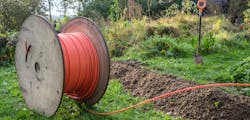When Plowing, Why Use Direct Bury or Fiber in Conduit?
In response to a great majority of comments I see, everyone needs to keep in mind that the Utility Owner ultimately drives the decision whether to direct buy or place fiber in conduit. It’s an uphill battle trying to convince someone leading a 40-mile project to add 211,000 feet of inner duct to a job that they plan to direct bury.
Clearly there’s no question that a direct buried fiber is it a greater risk of damage than one inside of conduit. However from the utility owner’s point of view, it’s a matter of budget. Whenever there are maintenance items or system improvements, the expense of placing an extra or spare pipe is an additional cost. There’s no immediate benefit to the budget or to utility owner.
Placing conduit on the job definitely lowers cost for outages or damages. But the locate work is contracted out, and the utility owner is not ultimately responsible for the cost of the damage. So, once again it’s about perspective. What matters to the utility owner is that the installation method is cost-neutral.
InvisiLight® Solution for Deploying Fiber
April 2, 2022Go to Market Faster. Speed up Network Deployment
April 2, 2022Episode 10: Fiber Optic Closure Specs Explained…
April 1, 2022Food for Thought from Our 2022 ICT Visionaries
April 1, 2022In support of direct buried fiber, it’s important to understand that excavating complications can occur when there’s fiber inside a conduit. That’s because there’s nothing to stop the fiber from moving within the conduit. So if you’re excavating and you snag the fiber, it could wrap around your plowing equipment and/or be pulled apart at a location that’s completely different from where you’re actually working.
Consider this case. When Dominion energy, located in Northern Virginia, began placing their service lines inside conduit, they ran into problems. It seemed every time an operator snagged a service line, a meter was pulled off a house or the transformer was damaged – or, even worse, sometimes both occurred. Ultimately this resulted in a massive increase in repair costs to the contractor.
By contrast, when fiber is direct buried, installers can accidentally break the line where they are actually digging. Typically the repaired splice point will then be put relatively close to the damage and the repair cost will be much lower. Of course, the impact to the customer is the same. But in terms of expense for repairs, direct bury is a much better option for the utility owner.
The bottom line is, well, the bottom line. Unfortunately, we live in a time that budget is priority, and building a solid backbone infrastructure for the long-term is no longer the gold standard.
I believe by installing a solid communications network inside innerduct with locate wire properly grounded, we would give locators the best chance to be successful, and give the customer the best opportunity to have and maintain reliable service. That would be the best option for all parties involved. But that means the stakeholders must install quality innerduct, with additional pipes for all lines, and solid vaults for access, splicing, and expansion. It also means locator access should be the rule.
With 20 years of experience, I would love to see our industry get back to those days. And with luck, someday we will.




